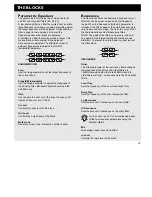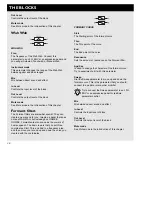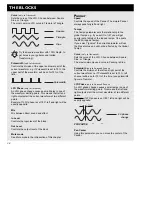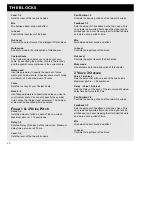
49
THE BLOCKS
The Reverb Block
The Reverb in the G-Force is based on the heritage of
the M5000 and M2000, and are tuned for guitar use.
REVERB
The Reverb section of the G-Force can create a variety
of Reverb effects including the feature of emulating the
initial reflections of a room which creates some mind
blowing spatial effects until now only available in the TC
M5000.
When using the G-Force reverb, you should see the
reverb as two parts:
1. Initial room reflections
2. The Decay
The initial room reflections are, depending on the size of
the room, the first 50-200ms of the Reverb and it is these
reflections that contains the information of the size and
shape of a room and create the width and most of the
depth experienced in a real hall or room.
The Decay is the later part of a natural reverb which is
experienced as prolonging the sound and creating some
depth behind the source or direct signal, but integrating it
in the spatial characteristics of the hall or room, like you
experience in natural ambience or reverb.
By emulating the initial room reflections the G-Force can
create some very deep and wide stereo images placing
the source or direct signal in the hall/room without using
long decay times which often makes the sound image
very “crowded” and disturbs your playing.
To check out what the initial reflections can do, reduce or
turn down the Decay level in the Decay parameters
section and turn up Room level in the Room parameters
section. Then try to change the Room size and the Room
shape in the Master section and choose the combination
that you like.
Then try to change the Color in the Room parameters
section to find the tonal balance that suits you.
You will hear a short spatial reverb which sounds a little
like a “gated “ reverb. Then at last add the decay by
turning up the Decay level in the Decay parameters
section and select the decay time that you prefer.
You will also hear that you are able to create a very
spatially wide and deep stereo reverb, with a relatively
short and low level decay.
When listening to the Reverb’s initial reflections alone at
a high level and when selecting Room size XL, Grand or
Huge, you might get a “slapback” effect, but by adding
the right length and amount of decay and by balancing
the Room level you will find that it will be transformed
into width and depth.
Square A typical square room with its defined
reflection patterns.
Round A diffuse room with lively reflections.
Curved A soft, yet still defined set of the reflections.
Room size
Sets the size of the room that the initial room reflections
emulate.
It automatically changes the length of the Predelay (the
time until the first reflection appears) and the Decay start
(the time where the Decay tail of the Reverb starts).
The Predelay and the Decay start can be individually
adjusted to another length in the Room and Decay
section of the algorithm.
Box - Tiny - Small - Medium - Large - XL - Grand - Huge
The sizes: Box, Tiny, Grand & Huge are patterns
emulating extreme room sizes.
Reverb level
Adjusts the combined Room level and the Decay level,
and should be seen as a master level.
The Room level and the Decay can individually adjusted
to another relation in the Room and Decay section of the
algorithm. Range +/-50.













































